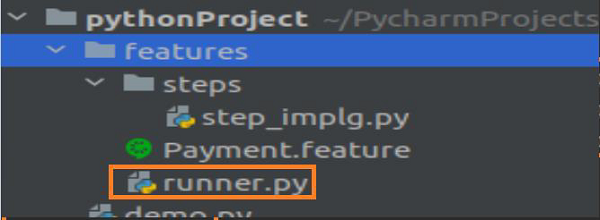
- Behave教程
- Behave - 主页
- Behave - 简介
- Behave - 安装
- Behave - 命令行
- Behave - 配置文件
- Behave - 功能测试设置
- Behave - 小Cucumber关键词
- Behave - 功能文件
- Behave - 步骤实施
- Behave - 第一步
- Behave - 支持的语言
- Behave - 步骤参数
- Behave - 场景大纲
- Behave - 多行文本
- Behave - 设置表
- Behave - 一步一步
- Behave - 背景
- Behave - 数据类型
- Behave - 标签
- Behave - 枚举
- Behave - 步骤匹配器
- Behave - 正则表达式
- Behave - 可选部分
- Behave - 多种方法
- Behave - 阶跃函数
- Behave - 步骤参数
- Behave - 运行脚本
- Behave - 排除测试
- Behave - 重试机制
- Behave - 报告
- Behave - 钩子
- Behave - 调试
- Behave有用的资源
- Behave - 快速指南
- Behave - 有用的资源
- Behave - 讨论
Behave - 运行脚本
我们可以通过运行命令行参数来运行Behave测试,或者我们可以创建一个运行程序脚本。该脚本提供了运行测试并生成相应报告的规定。
我们可以重试并执行失败的测试。此外,在执行整个套件之前,运行程序脚本能够进行应用程序编程接口 (API) 调用并确保 API 没有问题。
运行脚本的步骤
按照下面给出的步骤在 Behave 中成功创建并执行运行程序脚本。
步骤 1 - 在 features 文件夹中创建一个运行程序脚本 (runner.py)。
您的计算机上将出现以下屏幕 -

步骤 2 - 运行脚本实现来运行测试
可以使用下面提到的代码来实现运行程序脚本来运行测试 -
import subprocess
if __name__ == '__main__':
#command line args along with error capture on failure with check true
s = subprocess.run('behave --no-capture',shell=True, check=True)
步骤 3 - 执行运行器脚本
使用命令python3 runner.py执行 runner.py 文件(如果 Python 版本为 3)。您的计算机上将出现以下屏幕:

步骤 4 - 通过传递命令行参数来参数化运行程序脚本。
运行测试的运行程序脚本实现可以按如下方式完成 -
import argparse
import subprocess
if __name__ == '__main__':
p = argparse.ArgumentParser()
#--testdir command line argument added
p.add_argument('--testdir', required=False, help="File path")
a = p.parse_args()
testdir = a.testdir
#complete command
c= f'behave --no-capture {testdir}'
s = subprocess.run(c, shell=True, check=True)
步骤 5 - 执行运行器脚本
使用命令 python3 runner.py --testdir=features 执行 runner.py 文件。
